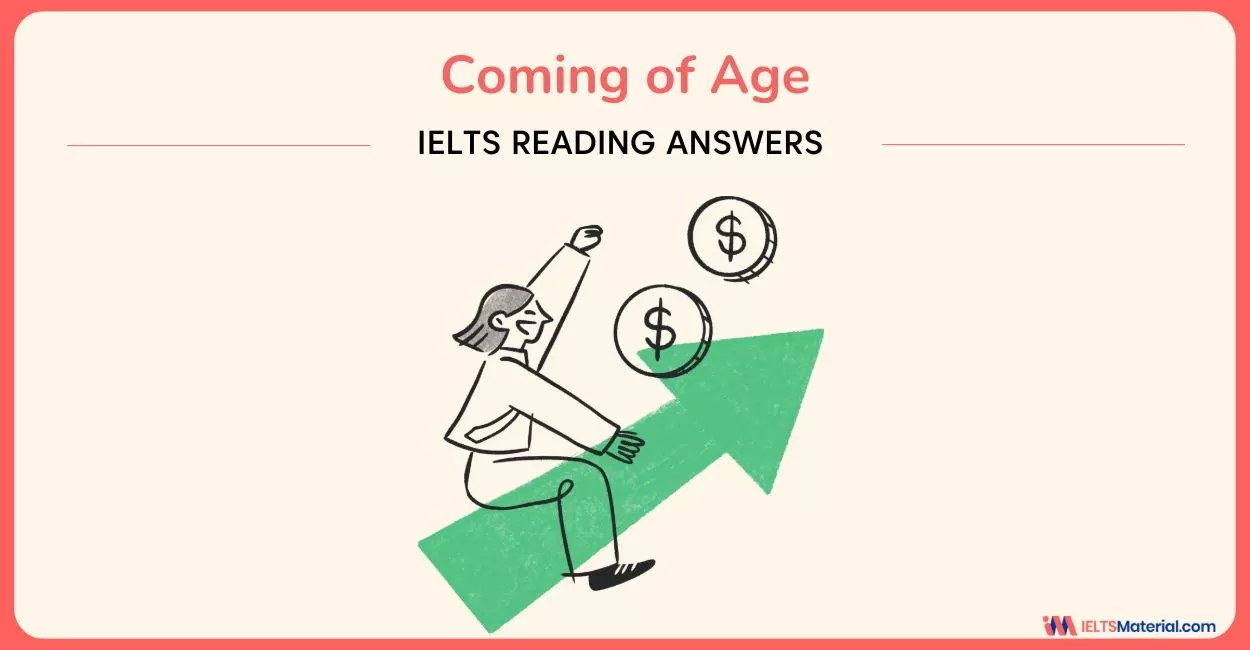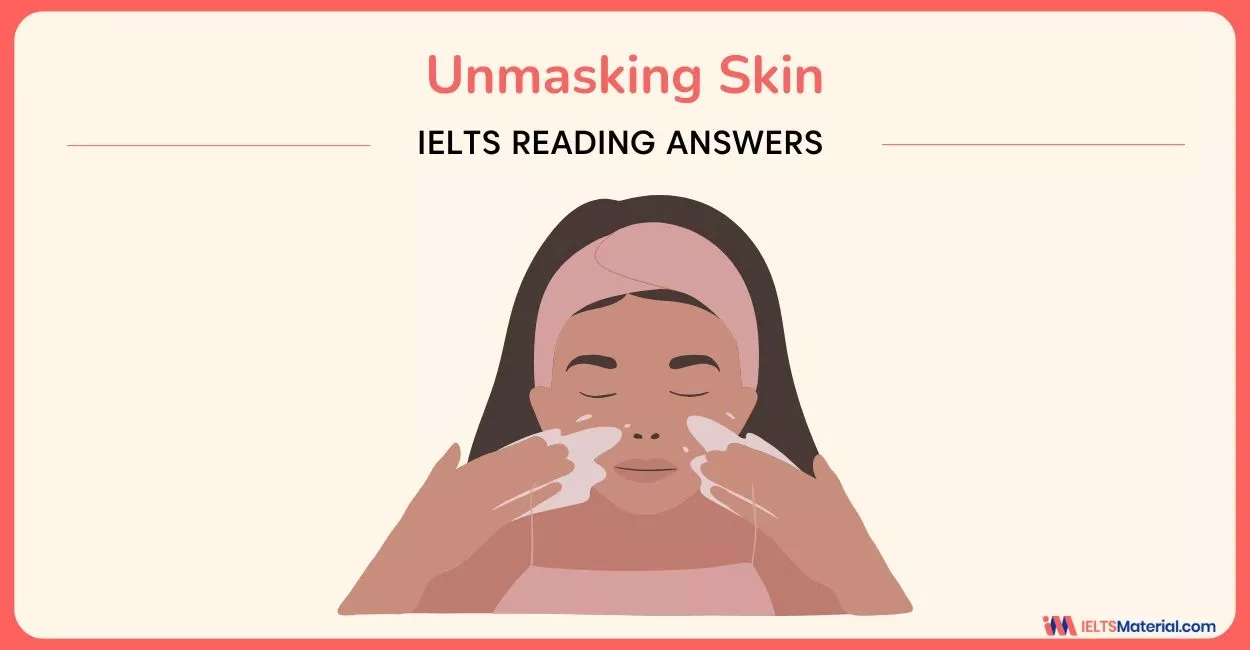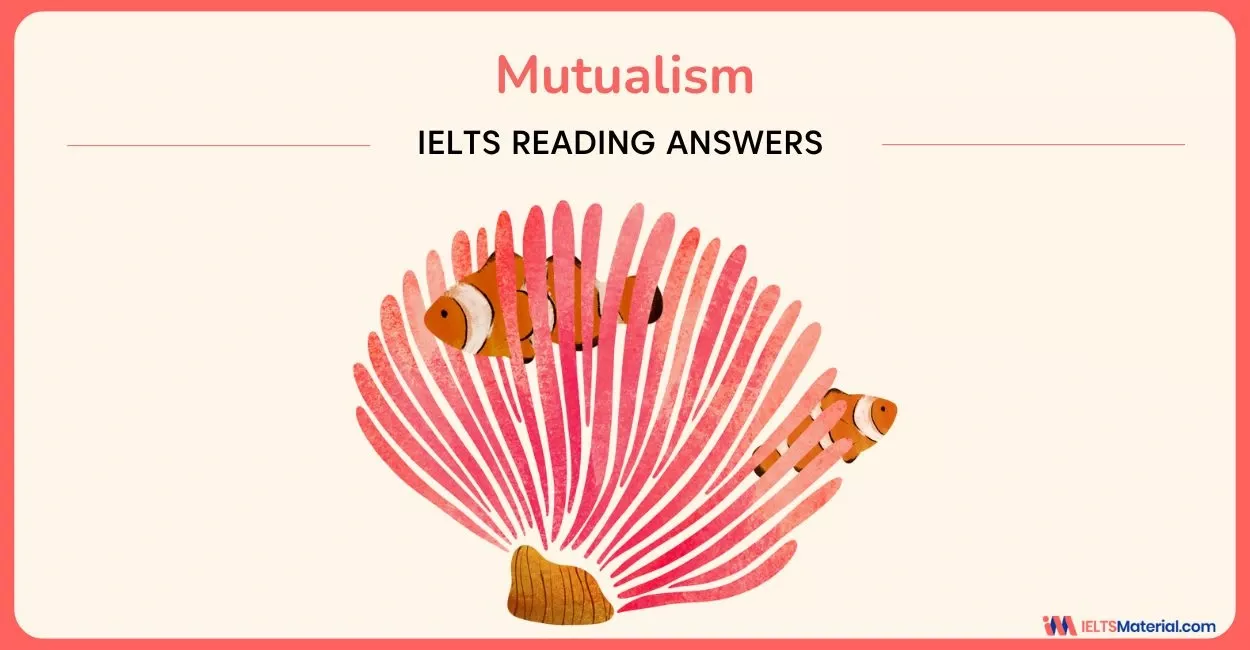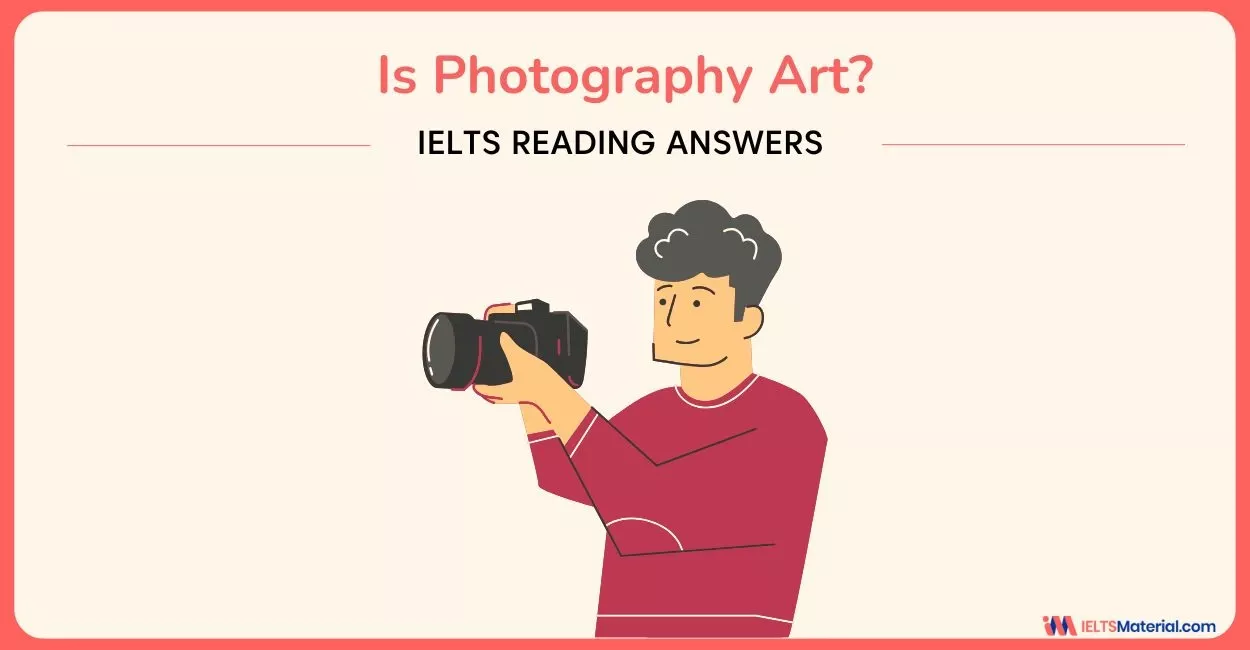Is Photography Art - IELTS Reading Answers
16 min read
Updated On
-
Copy link
Boost your IELTS reading band score to 8 and above by using the ‘Is Photography Art’ IELTS reading passage and its answer key. Also, learn to deal with different IELTS reading questions with the tips here and refine your reading strategy.
Table of Contents

Limited-Time Offer : Access a FREE 10-Day IELTS Study Plan!
Getting ready for the IELTS Reading section means understanding its unique structure. With 40 questions spread over three passages and just 60 minutes on the clock, mastering the format through single passages like ‘Is Photography Art IELTS Reading Answers’ from the best IELTS Reading books is your first step toward success.
So, solve the questions with the passage ‘Is Photography Art Reading Answers’ given below, check your answers against the provided location and explanations, and improve your performance in the reading module.
Passage for Is Photography Art IELTS Reading Answers
Now go through the passage for ‘Is Photography Art’ Reading Answers given below, and be prepared to solve similar IELTS Reading topics for General and Academic for the reading section.
You should spend about 20 minutes on Questions 27-40, which are based on the Reading Passage below.
Is Photography Art?
This may seem a pointless question today. Surrounded as we are by thousands of photographs, most of us take for granted that, in addition to supplying information and seducing customers, images also serve as decoration, afford spiritual enrichment, and provide significant insights into the passing scene. But in the decades following the discovery of photography, this question reflected the search for ways to fit the mechanical medium into the traditional schemes of artistic expression.
The much-publicized pronouncement by painter Paul Delaroche that the daguerreotype* signalled the end of painting is perplexing because this clever artist also forecast the usefulness of the medium for graphic artists in a letter written in 1839. Nevertheless, it is symptomatic of the swing between the outright rejection and qualified acceptance of the medium that was fairly typical of the artistic establishment. Discussion of the role of photography in art was especially spirited in France, where the internal policies of the time had created a large pool of artists, but it was also taken up by important voices in England. In both countries, public interest in this topic was a reflection of the belief that national stature and achievement in the arts were related.
From the maze of conflicting statements and heated articles on the subject, three main positions about the potential of camera art emerged. The simplest, entertained by many painters and a section of the public, was that photographs should not be considered ‘art’ because they were made with a mechanical device and by physical and chemical phenomena instead of by human hand and spirit; to some, camera images seemed to have more in common with fabric produced by machinery in a mill than with handmade creations fired by inspiration. The second widely held view, shared by painters, some photographers, and some critics, was that photographs would be useful to art but should not be considered equal in creativeness to drawing and painting. Lastly, by assuming that the process was comparable to other techniques such as etching and lithography, a fair number of individuals realized that camera images were or could be as significant as handmade works of art and that they might have a positive influence on the arts and on culture in general.
Artists reacted to photography in various ways. Many portrait painters - miniaturists in particular - who realized that photography represented the ‘handwriting on the wall’ became involved with daguerreotyping or paper photography in an effort to save their careers; some incorporated it with painting, while others renounced painting altogether. Still other painters, the most prominent among them the French painter, Jean- Auguste-Dominique Ingres, began almost immediately to use photography to make a record of their own output and also to provide themselves with source material for poses and backgrounds, vigorously denying at the same time its influence on their vision or its claims as art.
The view that photographs might be worthwhile to artists was enunciated in considerable detail by Lacan and Francis Wey. The latter, an art and literary critic, who eventually recognised that camera images could be inspired as well as informative, suggested that they would lead to greater naturalness in the graphic depiction of anatomy, clothing, likeness, expression, and landscape. By studying photographs, true artists, he claimed, would be relieved of menial tasks and become free to devote themselves to the more important spiritual aspects of their work.
Wey left unstated what the incompetent artist might do as an alternative, but according to the influential French critic and poet Charles Baudelaire, writing in response to an exhibition of photography in 1859, lazy and untalented painters would become photographers. Fired by a belief in art as an imaginative embodiment of cultivated ideas and dreams, Baudelaire regarded photography as ‘a very humble servant of art and science’; a medium largely unable to transcend ‘external reality’. For this critic, photography was linked with ‘the great industrial madness’ of the time, which in his eyes exercised disastrous consequences on the spiritual qualities of life and art.
Eugene Delacroix was the most prominent of the French artists who welcomed photography as help-mate but recognized its limitations. Regretting that ‘such a wonderful invention’ had arrived so late in his lifetime, he still took lessons in daguerreotyping, and both commissioned and collected photographs. Delacroix’s enthusiasm for the medium can be sensed in a journal entry noting that if photographs were used as they should be, an artist might ‘raise himself to heights that we do not yet know’.
The question of whether the photograph was document or art aroused interest in England also. The most important statement on this matter was an unsigned article that concluded that while photography had a role to play, it should not be ‘constrained’ into ‘competition’ with art; a more stringent viewpoint led critic Philip Gilbert Hamerton to dismiss images as ‘narrow in range, emphatic in assertion, telling one truth for ten falsehoods’.
These writers reflected the opposition of a section of the cultural elite in England and France to the ‘cheapening of art’ which the growing acceptance and purchase of camera pictures by the middle class represented. Technology made photographic images a common sight in the shop windows of Regent Street and Piccadilly in London and the commercial boulevards of Paris. In London, for example, there were at the time some 130 commercial establishments where portraits, landscapes, and photographic reproductions of works of art could be bought. This appeal to the middle class convinced the elite that photographs would foster a desire for realism instead of idealism, even though some critics recognized that the work of individual photographers might display an uplifting style and substance that was consistent with the defining characteristics of art.
These writers reflected the opposition of a section of the cultural elite in England and France to the ‘cheapening of art’ which the growing acceptance and purchase of camera pictures by the middle class represented. Technology made photographic images a common sight in the shop windows of Regent Street and Piccadilly in London and the commercial boulevards of Paris. In London, for example, there were at the time some 130 commercial establishments where portraits, landscapes, and photographic reproductions of works of art could be bought. This appeal to the middle class convinced the elite that photographs would foster a desire for realism instead of idealism, even though some critics recognized that the work of individual photographers might display an uplifting style and substance that was consistent with the defining characteristics of art.
* the name given to the first commercially successful photographic images.
Questions for Is Photography Art Reading Answers
The passage, Is Photography Art Reading Answers, consists of 14 questions, which showcase three different IELTS Reading question types. They are:
- IELTS Reading Multiple-Choice Question (Q. 27-30)
- IELTS Reading Summary Completion (Q. 31-34)
- IELTS Reading Matching Features (Q. 35-40)
Questions 27-30
Choose the correct letter, A, B, C or D.
Write your answers in boxes 27-30 on your answer sheet.
27 What is the writer’s main point in the first paragraph?
A photography is used for many different purposes.
B photographers and artists have the same principal aims.
C Photography has not always been a readily accepted art form.
D photographers today are more creative than those of the past.
28 What public view about artists was shared by the French and the English?
A that only artists could reflect a culture’s true values
B that only artists were qualified to judge photography
C that artists could lose work as a result of photography
D that artist success raised a country’s international profile
29 What does the writer mean by “the handwriting on the wall” in the second line of paragraph 4?
A an example of poor talent
B a message that cannot be trusted
C an advertisement for something new
D a signal that something bad will happen
30 What was the result of the widespread availability of photographs to the middle classes?
A The most educated worried about its impact on public taste.
B It helped artists appreciate the merits of photography.
C Improvements were made in photographic methods.
D It led to a reduction in the price of photographs.
Questions 31-34
Complete the summary of Paragraph 3 using the list of words, A-G, below.
Write your answers in boxes 31-34 on your answer sheet.
|
inventive |
similar |
beneficial |
next |
|
mixed |
justified |
inferior |
In the early days of photography, opinions on its future were 31 ............................, but three clear views emerged. A large number of artists and ordinary people saw photographs as 32 ............................ to because of the way they were produced. Another popular view was that photographs could have a role to play in the art world, despite the photographer being less 33............................... Finally, a smaller number of people suspected that the impact of photography on art and society could be 34...........................
Questions 35-40
Look at the following statements and the list of people, A-E, below.
Match each statement with the correct person.
Write the correct letter, A-E, in boxes 35-40 on your answer sheet.
35 He claimed that photography would make paintings more realistic.
36 He highlighted the limitations and deceptions of the
37 He documented his production of artwork by photographing his works.
38 He noted the potential for photography to enrich artistic talent.
39 He based some of the scenes in his paintings on photographs.
40 He felt photography was part of the trend towards greater mechanisation.
A Jean-Auguste-Dominique Ingres
B Francis Wey
C Charles Baudelaire
D Eugene Delacroix
EPhilip Gilbert Hamerton
Learn quick methods to conquer passages like this within 20 minutes.
Join our FREE IELTS webinars!
Answers and Explanations of Is Photography Art IELTS Reading Passage
In this section, you can examine the answers that have been provided to you, alongside the explanation that will aid you in identifying the answers. Check out 'Is Photography Art' answers and assess your improvement for a high IELTS band score.
| Question number | Answer | Explanation |
|---|---|---|
| 27 | C | Paragraph A points out that as we are surrounded by thousands of photographs, most of us ‘take for granted’ that, ‘in addition to supplying information and seducing customers’, camera images also ‘serve as decoration, afford spiritual enrichment, and provide significant insights into the passing scene’. But in the decades following the discovery of photography, this question reflected the ‘search for ways’ (was not readily accepted) to fit ‘the mechanical medium’ (camera) into the ‘traditional schemes’ of ‘artistic expression’ (art form). Hence, the answer is C (Photography has not always been a readily accepted art form). |
| 28 | D | Paragraph B explains that ‘discussion of the role of photography in art’ was especially ‘spirited in France’, where the ‘’internal policies of the time had created a large pool of artists, but it was ‘also taken up by important voices in England’. In both countries (France and England), ‘public interest’ in ‘this topic’ (role of photography in art) was a ‘reflection’ of the belief that ‘national stature and achievement in the arts were related’ (raises a country’s international profile). Hence, the answer is D (that artist success raised a country’s international profile). |
| 29 | D | Paragraph D informs that many ‘portrait painters’ – miniaturists in particular – who ‘realized that photography’ represented the ‘handwriting on the wall’ became involved with daguerreotyping or paper photography in an ‘effort to save their careers’ (bad thing that may happen to them); some incorporated it with painting, while others ‘renounced painting altogether’. Hence, the answer is D (a signal that something bad will happen). |
| 30 | A | Paragraph I reflected the ‘opposition’ of a section of the ‘cultural elite’ (most educated) in England and France to the ‘cheapening of art’ which the ‘growing acceptance and purchase of camera pictures by the middle class represented’. This appeal to the middle class convinced the elite that ‘photographs’ would ‘foster a desire for realism instead of idealism’. Hence, the answer is A (The most educated worried about its impact on public taste). |
| 31 | E | Paragraph C brings out the fact that from the maze of ‘conflicting statements and heated articles’ (mixed) on the ‘subject’ (photography), ‘three main positions’ (three clear views) about the potential of camera art ‘emerged’. Hence, the answer is E (mixed). |
| 32 | G | Paragraph C mentions that the simplest theory related to photography entertained by ‘many painters’ (artists) and ‘a section of the public’ (ordinary people), was that ‘photographs should not be considered ‘art’’ because they ‘were made with a mechanical device and by physical and chemical phenomena’ (the way they are produced) instead of ‘by human hand and spirit’ (how paintings were made). Moreover, the second widely held view, shared by painters, some photographers, and some critics, was that ‘photographs’ would be useful to art but ‘should not be considered equal’ (inferior) in ‘creativeness to drawing and painting’. Hence, the answer is G (inferior). |
| 33 | A | Paragraph C states the second widely held view, shared by painters, some photographers, and some critics, was that photographs would be useful to art but should ‘not be considered equal in creativeness (inventive)’ to drawing and painting. Moreover, in paragraph F, Charles Baudelaire, wrote in 1859, ‘lazy and untalented painters would become photographers’. Hence, the answer is A (inventive). |
| 34 | C | Paragraph C informs about the third opinion about photography, which is, by assuming that the process was comparable to other techniques such as etching and lithography, a ‘fair number of individuals’ realized that ‘camera images’ (photographs) could be as ‘significant as handmade works of art’ and that they might have a ‘positive’ (beneficial) ‘influence on the arts and on culture in general’. Hence, the answer is C (beneficial). |
| 35 | B | Paragraph E presents the view that photographs might be worthwhile to artists was ‘enunciated’ (claimed) in considerable detail by ‘Lacan and Francis Wey’. The ‘latter’ (Francis Wey), an art and literary critic, who eventually ‘recognised’ that ‘camera images’ (photographs) could be inspired as well as informative, suggested that they would lead to ‘greater naturalness’ (realistic) in the ‘graphic depiction’ (painting) of anatomy, clothing, likeness, expression, and landscape. Hence, the answer is B (Francis Wey). |
| 36 | E | Paragraph H notes the most important statement on this matter was an unsigned article that concluded that while photography had a role to play, it should not be ‘constrained’ into ‘competition’ with art; a ‘more stringent viewpoint’ led critic Philip Gilbert Hamerton to dismiss ‘camera images’ as ‘’narrow in range’ (limitation), emphatic in assertion, telling one truth for ten ‘falsehoods’ (deceptions)’. Hence, the answer is E (Philip Gilbert Hamerton). |
| 37 | A | Paragraph D cites an example of the French painter, ‘Jean- Auguste-Dominique Ingres’, began almost immediately to ‘use photography’ to make a record (documented) of their ‘own output’ (production of artwork). Hence, the answer is A (Jean-Auguste-Dominique Ingres). |
| 38 | D | Paragraph G presents that Eugene Delacroix was the most prominent of the French artists who ‘welcomed photography as help-mate’ (noted the potential of photography). Delacroix’s enthusiasm for the medium can be sensed in a journal entry noting that if photographs were used as they should be, ‘an artist might ‘raise himself to heights that we do not yet know’’ (enrich artistry talent). Hence, the answer is D (Eugene Delacroix). |
| 39 | A | Paragraph D tells about the French painter, ‘Jean- Auguste-Dominique Ingres’, began almost immediately to use ‘photography’ to make a record of their own output and also to provide themselves with source material for poses and backgrounds (based some of the scenes in his painting on photographs). Hence, the answer is A (Jean-Auguste-Dominique Ingres). |
| 40 | C | Paragraph F provided information on ‘French critic and poet Charles Baudelaire’ who ‘regarded photography’ as ‘a very humble servant of art and science’; a medium largely unable to transcend ‘external reality’. For this critic, photography was ‘linked with ‘the great industrial madness’ of the time’ (trend towards greater mechanisation), which in his eyes ‘exercised disastrous consequences on the spiritual qualities of life and art’. Hence, the answer is C (Charles Baudelaire). |
Learn quick solving tips and reading techniques from experts!
Connect with us through our FREE IELTS online classes!
Tips for Answering the Question Types in the Is Photography Art? Reading Passage
Given below are some IELTS exam preparation tips for band score of 8+ by helping you answer the types of questions in the ‘Is Photography Art’ Reading Answers.
Multiple-Choice Questions
- Read the question stem first, not the options: Before even looking at A–D, read the whole question to understand what type of information is needed, like the main point (look for overall idea), what does the writer mean by… ( look for interpretation) and what was the result (look for effect or consequence). This prevents you from getting confused by distractor options.
- Underline the question keywords before reading the paragraph. For example ‘main point’, ‘public view’, ‘what the writer means’, ‘result of’. This anchors your attention when scanning the passage.
- When a question asks about ‘main point’, read only the first paragraph: IELTS MCQs often refer to paragraph-level meaning. For Q. 27-30, the paragraph mentioned in the question is the only one you need. Do not read the whole passage. Stay within the boundary given.
- Eliminate answers based on tone mismatch: If the paragraph has a tone of criticism, eliminate positive answers; neutral information, eliminate emotional answers; future prediction, eliminate past-focused options.
- Match synonyms, not exact words. IELTS passages rarely repeat the text exactly.
- For “What does the writer mean by…?” questions, look for an explanation in the same or next sentence. The phrase is usually immediately explained through examples, consequences, and comparisons. The correct answer will reflect the underlying meaning, not the literal words.
- Always check if an answer option is too specific. If the paragraph discusses something generally, but an answer option includes a time period, a social group, an extra detail, then it is usually a trap.
- Make sure the answer covers the whole question. If the option matches only part of the idea, one example, or one side of a contrast, it is not correct.
Summary Completion
- Read the entire summary first without looking at the word list. You must understand the overall meaning before evaluating words.
- Identify the grammar category before choosing the word. This instantly eliminates 40–60% of wrong words.
- Use the ‘tone prediction’ method. Look for clues in the summary such as ‘although’ (the missing word is usually negative), ‘finally’ (neutral or concluding idea), ‘a smaller number’ (minority/uncertain view). Predict the tone before selecting.
- Check whether the word fits the meaning, and grammar when inserted. Always read the complete sentence after inserting the option. If the sentence sounds ungrammatical, illogical or repetitive, it is wrong. Remember that the same word may fit logically but not grammatically.
Matching Features
- Read all statements first. Do not read the names in the beginning. This helps you understand what ‘actions’ or ‘opinions’ you are matching and group the statements by theme (e.g., ‘limitations’, ‘encouraging photography’, ‘mechanisation’).
- Highlight key verbs in each statement. These verbs tell you exactly what part of the paragraph to look for.
- Treat each person like a ‘keyword anchor’. Scan the passage for the person’s name, pronouns referring to them, their work or contribution. Stay within that section ONLY.
- Eliminate statements that contradict the person’s attitude. If the person’s paragraph criticises photography, eliminate statements showing support and praises photography, eliminate statements showing doubt. Tone is very important.
- Watch out for names mentioned more than once. Some individuals appear in historical background, critical opinions and examples of artwork, but the correct statement usually refers to their main argument or contribution, not just a passing mention.
- Map each person to one core idea. After reading their paragraph, summarise each person in 3–5 words. Now match these short summaries with the statements.
- Be careful: some statements may be true about photography but not linked to that person. If the content appears in the passage but is not attributed to that specific person, it is incorrect.
To conclude, reading samples, such as Is Photography Art? IELTS Reading Answers, and IELTS Reading practice tests are crucial. If you implement effective reading techniques, you will be able to increase your reading speed, which will make it easier to pinpoint the areas where you struggle, ultimately allowing you to better answer the diverse types of questions that are utilized to assess your understanding of reading comprehension.
Useful Links:
- Snow Makers - IELTS Reading Answers
- The Changing Role of Airports - IELTS Reading Answers
- Tracking Hurricanes - IELTS Reading Answers
- Irish Potato Famine - IELTS Reading Answers
- Early Childhood Education - IELTS Reading Answers
- Cork IELTS Reading Answers
- How to Finish 3 IELTS Reading Comprehension in Less Than 60 Mins?
Practice IELTS Reading based on question types

Start Preparing for IELTS: Get Your 10-Day Study Plan Today!
Explore other Reading Actual Tests

Kasturika Samanta

Nehasri Ravishenbagam

Kasturika Samanta

Kasturika Samanta
Recent Articles

Nehasri Ravishenbagam

Haniya Yashfeen

Haniya Yashfeen

Haniya Yashfeen




Post your Comments
1 Comment